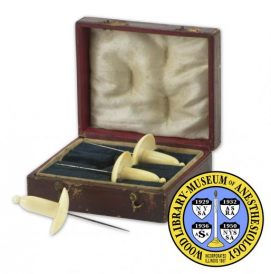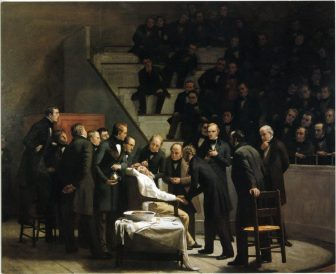A History of Anesthesia
- V. A. Cyr
- Jan 29
- 7 min read
Updated: Feb 19
This post is rich in history! What illicit drugs were used as common medicinal medications in the past? How did anesthesia advance the field of medicine through surgery? This post will review the historical and modern uses of anesthesia. Check out the topics to accompany this post: A History of Surgery: Part I & Part II!
Definitions & Types
Anesthesia
Anesthesia is a loss of sensation or pain relief. The word comes from the Greek words meaning “without” (an) and “sensation” (aisthesis).
Types of Anesthesia
Local Anesthesia
Local anesthesia is used to numb a part of the skin, usually before a procedure. Examples include Xylocaine (Lidocaine) used during a dental procedure and the EMLA patch (Lidocaine and Prilocaine) used before vaccinating a child.
Regional Anesthesia
Regional anesthesia, also called a nerve block, consists of anesthesia given to numb a specific area of the body. Examples of this include spinal anesthesia (an injection into the spinal column) and an epidural (intra-spinal catheter inserted to administer medication over more extended periods).
General Anesthesia
General anesthesia is when the body is unconscious, resulting in pain relief and muscle relaxation. This is usually administered intravenously (IV) and is a combination of many drugs to achieve homeostasis in the body while asleep.
Advanced Airways
Anesthesia causes the body to rest and decreases respiratory rate, pulse, and blood pressure. With the discovery of anesthetic agents, surgical abilities increased, and the airway quickly became essential to patient safety during procedures. In modern times, advanced airways are used for almost all surgical procedures to ensure oxygen delivery. This can be done in the hospital setting (i.e., intensive care unit), a community health clinic (e.g., dental surgery), and during cardiopulmonary resuscitation (CPR) efforts with a knowledgeable team. There are many types of airways used today, and their history is touched on in the Origins section below. Some examples are oral airways, LMAs, and endotracheal tubes (ETT). Oral airways consist of a rigid tube inserted into the mouth to keep the upper airway open. Laryngeal mask airways (LMAs) are longer, more flexible tubes that go into the mouth and extend into the larynx. Endotracheal (ETT) intubation goes from the mouth into the bronchus of the lungs. (The anatomy of the lungs can be reviewed in the post on A History of Auscultation!)

The differences between an ETT (left) and an LMA (right) (BMC Anesthesiuioogy).
Origins
Anesthetics are agents used to relieve pain—the earliest use of the Opium poppy by Sumerians began around 4000 BCE (Robinson & Toledo, 2012). In 2250 BCE, Babylonians relieve toothache with Henbane (Hyoscyamus niger, a type of nightshade flower). Around 1600 BCE, acupuncture was practiced for pain relief in China with bones and turtle shells (WLM, 2024)

Acupuncture needles made from bone and turtle shells from 1600 BCE (WLM, 2024).
In Homer’s Odyssey (written in 1187 BCE), the Greek goddess Circe uses deliriant herbs (Mandragora or Datura) in a brew to seemingly transform Odysseus’ men into swine (WLM, 2024). At the Oracle of Delphi in Greece, Apollo’s Pythian priestesses utter prophecies after breathing in fumes (possibly ethylene, an inhalational anesthetic) emerging from geologic fault lines beneath the Temple to Apollo (WLM, 2024). Around 600 BCE, India’s Sushruta used cannabis vapours to sedate surgical patients (WLM, 2024). In 400 BCE, Assyrians used carotid compression to produce brief unconsciousness before circumcision or cataract surgery (WLM, 2024). In 350 BCE, the Greek philosopher Plato refers to ANAIΣΘHΣIA (anesthesia in Greek) in his work Timaeus (WLM, 2024).
In 160, the Chinese physician Hua Tuo performed surgery using his general anesthetic called Mafeisan, a wine and herbal mixture (WLM, 2024). In the 800s-1200s, herbal mixtures, including Opium, Mandrake, Henbane, and/or Hemlock, were steeped into a soporific or sleep-bearing sponge (WLM, 2024). The sponge was then dampened to apply the anesthetic vapours to a patient’s nostrils. Around 1350, Inca shamans chewed coca (cocaine) leaves mixed with vegetable ash and dripped their cocaine-laden saliva into the wounds of patients as pain relief methods (WLM, 2024). In the 1500s, ether was used on animals and synthesized through distillation for human use (WLM, 2024). In 1659, Sir Christopher Wren and Anglo-Irish chemist Robert Boyle pioneered intravenous therapy (see A History of Bloodwork) by injecting opium through a goose quill into a dog’s vein (WLM, 2024). Between 1771 and 1786, Joseph Priestley, an English chemist and natural philosopher, discovered “airs” of oxygen and nitrous oxide and was the first to isolate oxygen (WLM, 2024). In 1800, Humphry Davy observed, “As nitrous oxide in its extensive operation appears capable of destroying physical pain, it may probably be used with advantage during surgical operations in which no great effusion of blood takes place” (WLM, 2024). In 1804, Japan’s Hanaoka Seishu formulated his general anesthetic, Tsusensan (a mixture of six medicinal herbs) (WLM, 2024). In 1805, Pharmacist Friedrich Sertürner isolated a new substance from opium, named “morphium” (morphine), after Morpheus (the god of dreams) (WLM, 2024).
In the later 1800s, ether became increasingly used in humans. In 1842, a medical student used ether on the first patient for a dental extraction. That same year, Dr. Crawford Long etherized a patient for the removal of neck cysts. In 1844, Dr. Horace Wells volunteered to inhale nitrous oxide for his own dental extraction. A year later, he demonstrated the effects of nitrous oxide anesthesia for a patient’s tooth extraction, which was met with controversial opinions (WLM, 2024).
Dr. William Morton, a Boston dentist, used nitrous oxide (N2O) as an anesthetic agent to perform a tooth extraction (WLM, 2024). On October 16th, 1846 (named “Ether Day”), he and another doctor completed the first-ever surgical procedure with an anesthetic (Robinson & Toledo, 2012).

A painting depicting of the first surgical procedure done with an anesthetic (ether) (WLM, 2024).
In 1847, Profesor James Simpson, a Scottish obstetrician, began administering chloroform to women for pain during childbirth (WLM, 2024). Chloroform quickly becomes a popular anesthetic for surgery and dental procedures as well. Anesthesiologist Dr. John Snow popularized obstetric anesthesia by chloroforming Queen Victoria for the birth of Prince Leopold (1853) and Princess Beatrice (1857) (WLM, 2024).
In 1853, the hollow hypodermic needle, combined with a syringe popularized in 1845, was invented (WLM, 2024). This made administering parenteral medications (i.e., intravenous, intramuscular, and subcutaneous injections) easier.

The Pitkin (left) and Record (right) syringes without needles (WLM, 2024).
In 1884, cocaine was used as an anesthetic for eye and dental surgeries (WLM, 2024). The first mandibular (jaw bone) nerve block was performed using cocaine (WLM, 2024).
In the 1880s, Joseph O’Dwyer created the first metal endotracheal tube for airways during surgery (Robinson & Toledo, 2012).
The first anesthesia record was made in 1894, monitoring Respiratory rate and palpated Pulse (WLM, 2024). By 1901, Blood Pressure measurements had been added (WLM, 2024). In 1903, respiratory and heart rate Auscultation was added to the record (WLM, 2024).
In 1898, Dr. August Bier conducted the first spinal anesthetic using cocaine (into the spinal cord). A decade later, he popularized the intravenous regional (“Bier”) nerve block (WLM, 2024).
In 1902, Dr. Frederic W. Hewitt administered a chloroform-ether mixture to the future King Edward VII (WLM, 2024). Hewitt later designed the oral “air-way” in 1908 (WLM, 2024). In 1905, a German chemist developed procaine and named the substance “Novocain” (WLM, 2024).
In 1914, Dr. Dennis E. Jackson developed a carbon dioxide-absorbing anesthesia system. This system allowed patients to re-breathe their exhaled air containing the anesthetic, resulting in the use of less anesthetic and the avoidance of waste (WLM, 2024). Ten years later, Dr. Ralph Waters developed the first simple and easily transportable absorber, known as the “Waters Canister” and the “Waters To-and-Fro” (WLM, 2024). In 1920, Arthur Guedel created the Guedel (oral) airway, which is still used today (WLM, 2024).
In 1929, doctors popularized using the intravenous anesthetic thiopental (Pentothal) (WLM, 2024). Thiopental’s popularity as a swift-onset intravenous agent for inducing general anesthesia paved the way for other IV induction agents, such as ketamine, etomidate, and propofol.
Arthur Guedel and Ralph Waters added a cuff to the tubes in 1932, allowing the practitioner to provide positive pressure ventilation (Robinson & Toledo, 2012). Anesthesiologist Chevalier Jackson created the portable laryngoscope to aid the insertion of the endotracheal tubes into the larynx (Robinson & Toledo, 2012).
Also, in 1932, barbiturates became popular in surgeries. Sodium thiopental became the induction drug of choice as it has a shorter recovery time and suppresses laryngeal reflexes (Robinson & Toledo, 2012).
In 1937, Professor Macintosh introduced the first curved laryngoscope blade, enabling physicians to see the larynx during intubation (WLM, 2024).
Many drugs were introduced in the mid-to-late 1900s. Lidocaine was introduced as a local anesthetic in 1944. Isoflurane was clinically introduced as an inhalational anesthetic in 1972. Other inhalational anesthetics were introduced in 1992 (Desflurane) and 1994 (Sevoflurane) (WLM, 2024).
Propofol was introduced in 1977 and has anti-emetic (anti-vomiting) effects that are helpful after surgery (Robinson & Toledo, 2012). This is the drug that is commonly used in surgeries today. An example of anesthesia used for a modern dental procedure under anesthesia could include all or a combination of propofol, remifentanyl (synthetic fentanyl), midazolam, and ketamine.
Timeline Throughout History : Anesthetic Drugs

Timeline Throughout History : Advanced Airways

Anesthesia tends to give people a euphoric (drunk or stoned) feeling. I have had a lot of patients make jokes and funny comments after waking up from surgery. Please share any funny anesthesia stories you have in the comments below!
– V. A. Cyr
References
BMC Anesthesiology. (2022). Different components of ETT and LMA. ETT—endotracheal tube; LMA— laryngeal mask airway [Image]. ResearchGate. https://www.researchgate.net/figure/Different-components-of-ETT-and-LMA-ETT-endotracheal-tube-LMA-laryngeal-mask-airway_fig1_362267823
College of Physicians of Philadelphia. (2020). Ormsby’s Inhaler [Image]. Historical Medical Library. https://histmed.collegeofphysicians.org/ether-in-surgery/
ICU Medical. (n.d.). SACETT™ Suction-Above-Cuff Endotracheal Tube [Image]. https://www.icumed.com/products/airway-management/general-anesthesia/intubation-systems/sacett-suction-above-cuff-endotracheal-tube/
Pfizer. (n.d.). Propofol Injectable Emulsion, USP (contains Benzyl Alcohol) [Image]. https://www.pfizerhospitalus.com/products/propofol
Robinson, D. H. & Toledo, A. H. (2012). Historical development of modern anesthesia. Journal of Investigative Surgery, 25(3), 141-149. 10.3109/08941939.2012.690328
Wood Library-Museum of Anesthesiology (WLM). (2024). History of Anesthesia [Images]. https://www.woodlibrarymuseum.org/history-of-anesthesia/#64

Comments